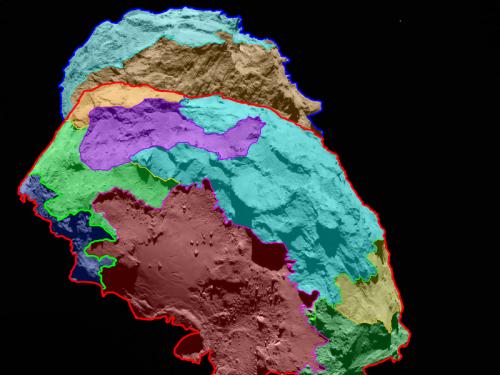 The point of the map is to differentiate different morphological sections of the comet – hence the bright colours. This has been achieved in a few short weeks, since Rosetta arrived in the vicinity of Churyumov-Gerasimenko. The images shows areas of the comet dominated by cliffs, depressions, boulders and grooves, a surprising number of different terrains – and no sign of a dirty snowball. The bumps and lumps appear to be shaped by activity that has occurred on the comet nucleus (dust and debris released via the coma).
The point of the map is to differentiate different morphological sections of the comet – hence the bright colours. This has been achieved in a few short weeks, since Rosetta arrived in the vicinity of Churyumov-Gerasimenko. The images shows areas of the comet dominated by cliffs, depressions, boulders and grooves, a surprising number of different terrains – and no sign of a dirty snowball. The bumps and lumps appear to be shaped by activity that has occurred on the comet nucleus (dust and debris released via the coma).
Meanwhile, reports of a meteorite punching a small hole near Managua, the main city of Nicaragua, are being investigated – go to http://phys.org/print329448584.html
Apparently, no one is said to have noticed the blazing light trail of the meteor as it raced across the night sky – but people were awoken by the explosion when it struck the ground. Once again it arrived at the very same time as an asteroid passed close to the Earth – last weekend. Was the meteorite in resonant orbit with the asteroid? The situation is reminiscent of what happened in 2013 when an asteroid passed close to the Earth and the Chelyabinsk meteor exploded in the atmosphere above Russia. Once again, NASA are denying a link – even denying the Nicaragua object was a meteorite. Interesting – are they bothered by the possibility that near earth objects may be more dangerous than the consensus view allows?
